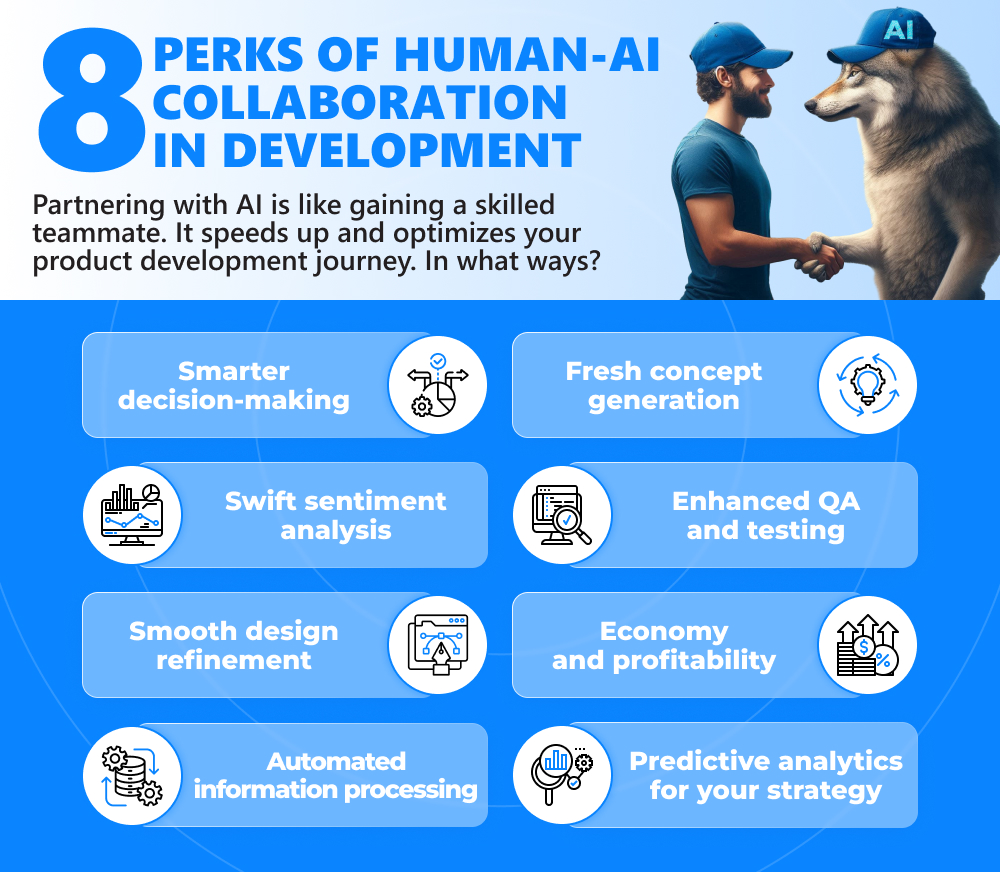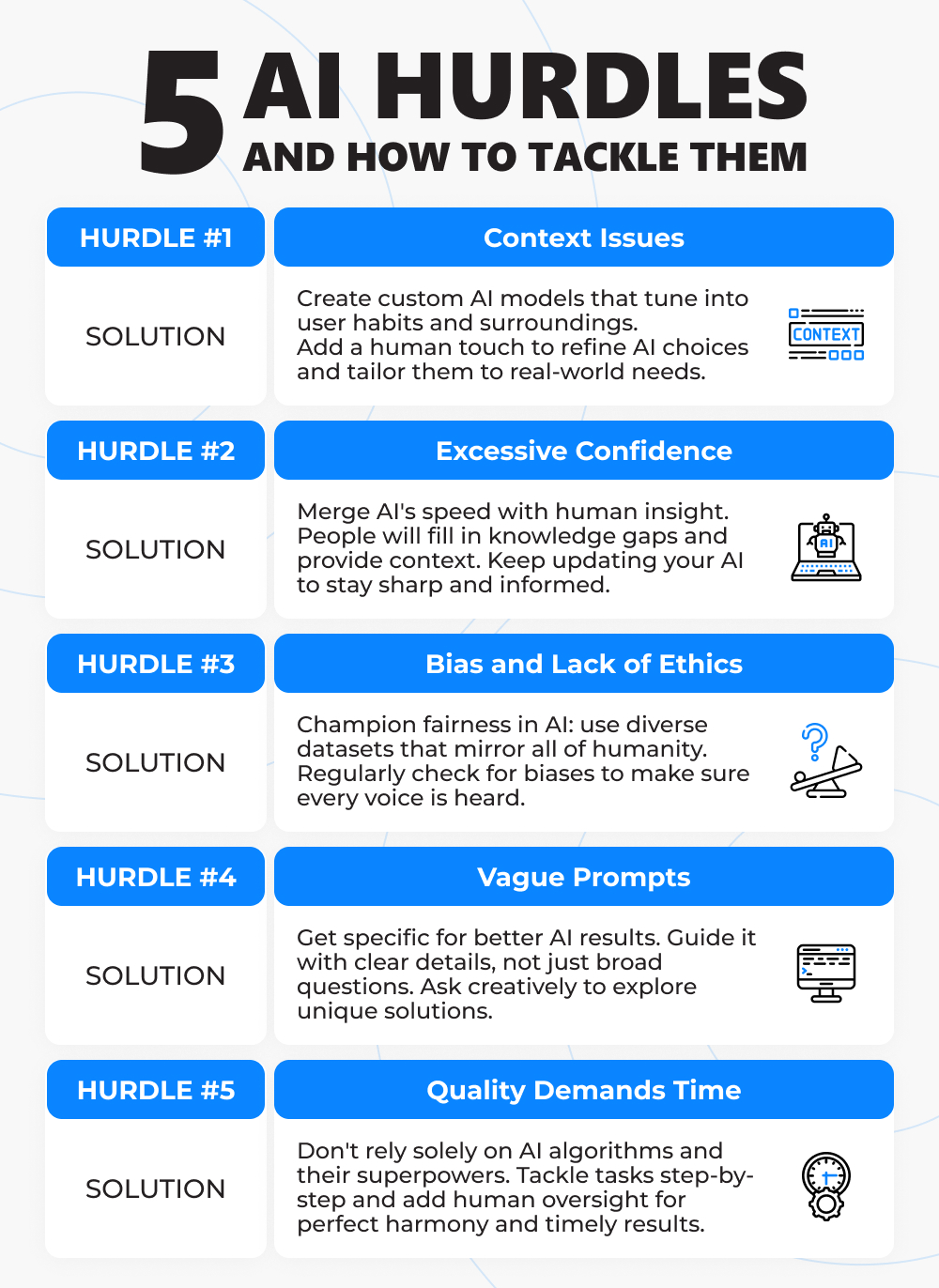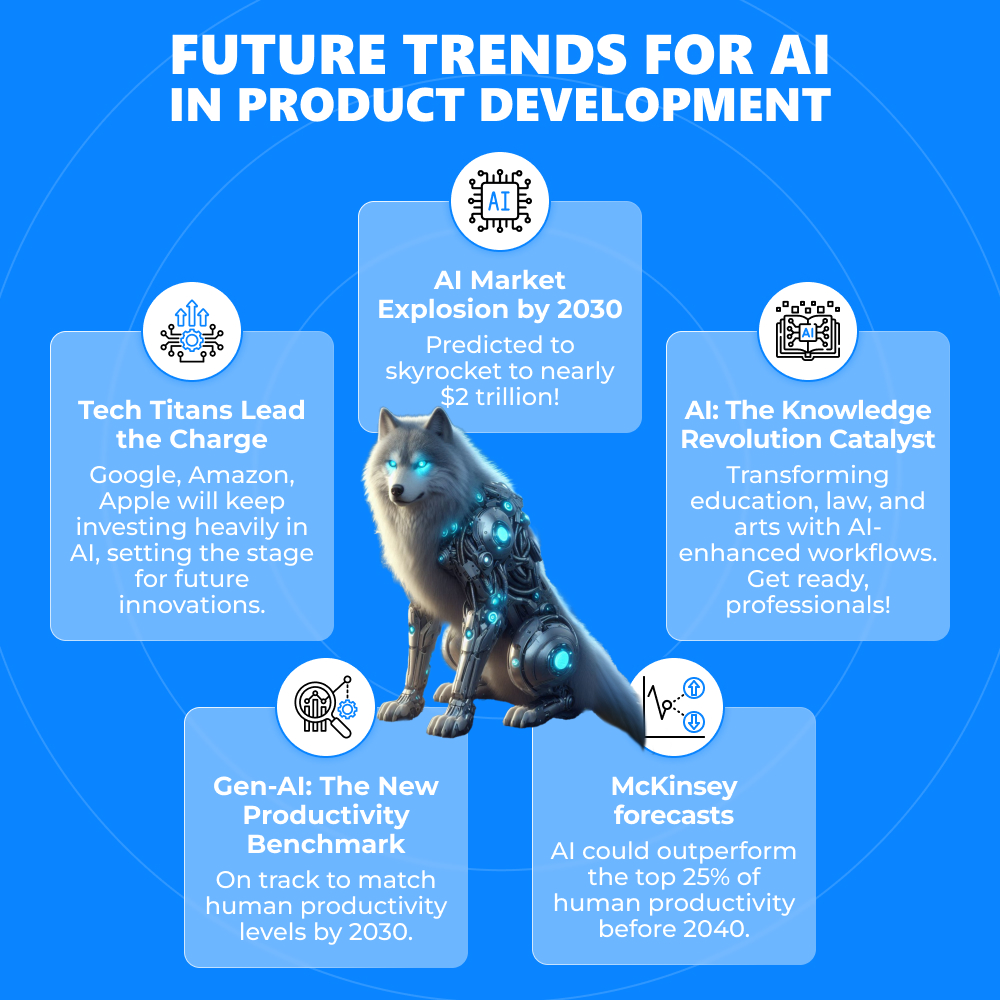AI in product development… Is it a good idea? Imagine a world where AI is not a tool, but a team member. It's Monday morning, and your new teammate rolls into the office. Well, not rolls, more like pings the team chat with a cheerful “Good morning!” It doesn't ask for coffee breaks and doesn't mind staying late to deploy that hotfix.
AI seems like a dream employee. The question arises: what value can this non-traditional team member bring to the company? Buckle up as we explore the quirks and perks of “hiring” generative AI to build products.
AI in product development… Is it a good idea? Imagine a world where AI is not a tool, but a team member. It's Monday morning, and your new teammate rolls into the office. Well, not rolls, more like pings the team chat with a cheerful “Good morning!” It doesn't ask for coffee breaks and doesn't mind staying late to deploy that hotfix.
AI seems like a dream employee. The question arises: what value can this non-traditional team member bring to the company? Buckle up as we explore the quirks and perks of “hiring” generative AI to build products.
Contents
Hello! I’m AI, Your New Teammate
Over the past few years, the phrase “Age of AI” has echoed through boardrooms, tech conferences, and bars. Some see it as an inspiration for groundbreaking technological progress. Others treat it with caution, convening conferences to debate whether AI is a harbinger of doom or a chance for humanity. The recent emergence of technologies like ChatGPT has emphasized its self-learning capabilities. This advancement has only reinforced the ubiquity of artificial intelligence.
Now you stand at a crossroads: should you welcome AI technology into your team or rely solely on human ingenuity?
Benefits of Human-AI Collaboration in the Development Cycle
When you choose to collaborate with AI, it opens the door for your new coworker to prove its worth. Take it as a sidekick who doesn't work alone, but rather amplifies your product development efforts.
You're not venturing into uncharted territory. Across the globe, software engineering teams have already joined forces with AI. An IBM survey reveals that 21% of companies now rely on robotic help as part of their daily operations. Among the early adopters, product managers stand out as one of the top 10 user groups leveraging AI.
But how can such a partnership benefit your own development team? Let's explore the role AI plays in the product development lifecycle:
- Smarter decision-making. AI systems automate product development tasks and propose decisions based on real-time data.
- Concept generation. The technology inspires product designers by generating fresh concepts. Imagine an AI-powered brainstorming session: human creativity doubled!
- Sentiment analysis. AI inspects brand mentions on social media to help teams gauge customer feedback and emotions — both positive and negative. Disappointed users are a powerful incentive for progress, aren't they?
- QA and testing. AI simulates how your solution behaves under different conditions (loads, stresses, etc.) before it hits the market.
- Design refinement. Collaborating with AI, product designers fine-tune their creations before the official release.
- Economies of scale. Automation replaces manual labor, enhancing efficiency and profitability. Thus, integrating AI in product development helps businesses scale without proportional cost increases.
- Market insights. AI offers a way to automate information processing through algorithms. It represents real-life scenarios as mathematical models, deriving insights based on calculated assumptions. Through data mining and data science, humans can scan loads of information. Social media trends, competitor moves, and economic signals enable low-risk decision-making.
- Predictive analytics. Will users find your app intuitive? How valuable are your clients along the journey? AI algorithms forecast these critical metrics, guiding your product strategy.
Key Use Cases of AI-Driven Product Development
AI integration goes beyond those quick-witted chatbots doing our jobs. It affects all stages of the product development life cycle. You can see it in the algorithms guessing which products your audience will love next. You can spot it in rigorous product testing before launch. And in virtual interviewers that gather user feedback. Where else?
Project Management
Where AI assists humans:
- Applying predictive analytics to analyze project data and forecast resource shortages or scheduling conflicts;
- Automating mindless tasks to free up managers for other aspects of product lifecycle management, like strategic planning;
- Assessing team members' skills and workloads to help managers match the right tasks to the right people.
Example:
A product manager at a gaming company uses AI to create a more organized workflow for an upcoming project.
Market Research
Aid from AI models:
- Automated data analysis and collection;
- Identifying market trends and competitor strategies for providing valuable insights into future audience interactions;
- Sentiment source exploration to gauge how consumers feel about specific products or services.
Example:
An AI system scans social media and web forums, predicting the rise of eco-friendly packaging before it becomes mainstream.
Product Architecture Design
With AI, you can:
- Generate designs based on customer data and preferences to use in the product engineering process;
- Examine previous design successes and failures to pick the ideal structure for a new app.
Example:
An IT startup collaborates with an AI product development company to analyze and refine the architecture requirements for a new cloud solution.
Software Frontend Design
AI can help you with:
- Mapping out user-first product UI designs after analyzing how your target audience interacts with the software;
- Automating repetitive tasks: layout design, color, and typography selection;
- Usability testing and optimization of UI elements, from button placements to navigation flows.
Example:
A frontend designer uses AI to track user navigation patterns. The technology suggests redesigning the checkout functionality to make the process efficient and customer-centric.
Automatic Code Generation
What to expect from AI:
- Writing code based on predefined rules, which greatly reduces software development time;
- Upholding strict coding rules to write high-quality code that adheres to the best practices in the industry.
Example:
With an AI coding assistant, a developer quickly generates the necessary API calls and front-end code, ensuring error-free operation. AI also offers optimizations, reducing page load time by 50%.
Automated DevOps
Where AI can assist:
- Historical data analysis;
- Foreseeing system anomalies (resource spikes or performance bottlenecks) and alerting DevOps teams;
- Using CI/CD to find optimal release windows, cut downtime, and deliver product features faster;
- Automated code review with actionable feedback, enhancing codebase health.
Example:
In a large online store, an AI system monitors server health and traffic dynamics. During a flash sale, it predicts server overload and dynamically redistributes the load. Thus, it guarantees a smooth shopping experience for millions of customers.
Product Security
Aid from AI:
- Timely threat recognition and detection of potential entryways for cybercriminals;
- Identity and Access Management (IAM) to flag suspicious activity, like unusual login patterns;
- Compiling threat intelligence data, suggesting detection rules, and aiding in malware reverse engineering.
Example:
A product security specialist at a bank decides to integrate AI for tracking network traffic. The smart tool detects a pattern of unauthorized access attempts. Then, it automatically triggers anti-malware measures, thwarting potential data leakage.
Quality Assurance
What AI offers:
- Automated testing with rare human errors — proven in AI-enhanced nuclear engineering;
- Machine verification of code changes, providing faster feedback loops and reducing manual efforts.
Example:
A QA specialist works with AI to automate the testing of a new mobile app. They run thousands of tests across several devices and operating systems. As a result, they identify previously undetected bugs.
Digital Marketing
Marketing with AI is:
- Customer segmentation and personalized content recommendations;
- Lead scoring and nurturing to focus on high-potential prospects and tailor marketing campaigns;
- Automated A/B testing of a minimum viable product (or final product) to identify winning variations.
Example:
A fashion brand marketer uses AI to segment their clientele. They analyze purchasing behavior and customer preferences to personalize email campaigns. This approach helps to multiply click-throughs and conversions.
Valuable AI Tools for Product Development
What's the word on AI-based tools for such a wide range of applications? Here's a handy table with noteworthy examples across various domains:
Use Case
AI-Powered Tools
Project Management
- Asana;
- Trello;
- Zapier;
- ClickUp;
- Basecamp.
Market Research
- Survey Monkey Genius;
- Poll the People;
- Remesh;
- Speak;
- YouScan.
Software Architecture Design
- AIDA;
- ChatGPT;
- Texta.
Frontend Design
- Canva;
- Uizard;
- Hostinger AI;
- Framer;
- Midjourney;
- Divi AI.
Code Generating
- GitHub Copilot;
- Replit GhostWriter
- Amazon CodeWhisperer
- Code by Sourcegraph
- Tabnine.
DevOps
- Amazon CodeGuru;
- Dynatrace;
- GitHub;
- Kubiya;
- Datadog.
Product Security
- Darktrace;
- Vectra AI;
- IronNet;
- Hunters;
- Secureworks Taegis.
QA & Testing
- ACCELQ;
- Katalon;
- Selenium;
- Appium;
- Cypress.
Digital Marketing
- Jasper AI;
- Surfer SEO;
- Notion AI;
- Zapier;
- Albert AI;
- Influencity.
Possible Risks and How to Tackle Them
Plenty of goodies, right?
The allure of AI in the production process is undeniable, promising a goldmine of possibilities. Yet, the case for AI is still not clear-cut. Just recently, notable celebrities have raised concerns by signing open letters opposing “AI Music-Generation Technology”. So, should you proceed with caution in the field of product development?
Let’s explore the risks that lie ahead and chart a course to navigate them.
Context? What Is It?
Unlike humans, AI systems lack a fine-grained understanding of context. They can take logical actions based on data alone. That's why AI sometimes seems tone-deaf or offensive. Without context awareness, its actions may conflict with social or ethical norms.
Solution:
Develop custom AI models that explicitly heed context cues, such as user history or environment. You can also try implementing human-in-the-loop systems to validate AI decisions and make context-aware adjustments.
Brainiac? Not Your Know-It-All
If terms like “machine learning tools”, “natural language processing”, and “computer vision” suggest AI knows everything on the internet, think again. The truth is: AI isn't omniscient. Despite its prowess, it can be overly confident, even when uncertain, leading to errors.
Solution:
Try to combine AI's speed with human judgment. People will fill in knowledge gaps and provide context. And remember to regularly update your models to refine their AI expertise and adapt to new information.
Ethical and Unbiased? Look Harder
AI learns from historical data, which often carries inherent biases. Plus, it can't always grasp evolving social norms. What was acceptable yesterday may no longer hold true today. And therein lies the risk: perpetuating discrimination against certain groups of individuals.
Solution:
To address ethical concerns, prioritize inclusive, representative datasets. Ensure they reflect the rich tapestry of humanity, not the majority. Regularly audit your training data for hidden biases. Especially regarding underrepresented groups — their voices matter.
User-Friendliness? Not Its Thing
Using tools like ChatGPT or Midjourney for generative AI product development reveals a unique skill set. Why is that? AI doesn’t create content out of thin air. It relies on existing data it was trained on. Your ability to “talk” to AI — that is, to craft meaningful queries — directly affects the quality of its responses.
Solution:
Specifics yield richer results. Thus, always provide the machine with context rather than a vague query. Instead of “Tell me about PMs and deadlines,” try asking, “Is it possible to invent a device that erases memories to make a PM forget about deadlines?”
Last-Minute Helper? 50/50
AI product development indeed enhances efficiency and productivity. But the notion that it magically solves the “need-it-done-yesterday” challenge is misleading. Crafting exceptional products involves more than an artificial intelligence design assistant alone. AI can't warp time. Quality still demands deliberate effort from product developers and designers.
Solution:
Missed deadlines? Don't rely solely on AI algorithms and their superpowers. Recognize their boundaries. To succeed, break tasks into manageable steps so the machine can handle them sequentially. Spice up the process with human oversight. It won't be an obstacle to the entire process, but a push for a balanced outcome.
Generative AI for Product Development: Future Trends
What will the global AI market be like by 2030? Statista predicts remarkable growth to nearly $2 trillion! But what factors will drive this surge? Here are some trends we may see shortly:
- Tech giants like Google, Amazon, and Apple will continue investing in AI research and development. Such efforts will prove their commitment to pushing the boundaries of robotic intelligence;
- AI is set to ignite a knowledge revolution across education, law, and the arts. Professionals in these fields should get ready for AI-assisted workflows;
- Gen-AI will reach human-level productivity soon. Some studies suggest it could match the average human task performance by 2030. While McKinsey states that some AI abilities may surpass the top 25% of human performance before 2040.
Ready to Get Started with AI Product Development?
Misguided are those who assume that AI is purely about sentient robots or science fiction fantasies. Instead, its essence lies in amplifying human creativity, doubling operational efficiency, and nurturing innovative ideas all along the product development journey. Luc Julia, co-inventor of Apple’s Siri and Renault’s Chief Scientific Officer, succinctly captures this point: “There is no intelligence in AI, but there is knowledge – of data and of rules – and there is recognition… Machines don’t invent anything; what they produce comes solely from the data we put into them.”
The success of your AI product development depends more on your dedication to the technology than just the complexity or newness of the AI model. With the right product development strategy and a qualified team, the unparalleled perks of AI — enhanced functionality, efficiency gains, and competitive advantage — are well within your reach.
Struggling to find a seasoned AI partner? Drop us a line. Our experts will blend data science, machine learning, and deep domain knowledge to craft your intelligent solution.
FAQ
It's the strategic integration of AI technologies into product development processes. In its essence, it's all about using artificial intelligence to simplify software engineering tasks, speed up project timelines, and create better products.
Sure! But remember that artificial intelligence (while still in its infancy) cannot completely replace designers and developers.
Here are the areas where AI can significantly contribute to product design:
- Idea generation and refinement;
- Concept development process automation;
- Predicting upcoming design trends;
- Visualizing concepts, mockups, and prototypes;
- Organizing and managing design-related data.
- Creativity boost. While creativity is inherently human, AI can double or even triple it in product development teams. For instance, by generating novel concepts and suggesting extraordinary solutions.
- Time & cost economy. Through routine task automation and a deep understanding of the workflow, AI frees designers to focus on creative work. This translates to cost savings for businesses.
Data-driven strategy. AI gathers information on customer behavior and preferences, market trends, and challenges. Armed with this data, designers can create products that resonate with the audience and proactively address their pain points.
- Automated product development. AI is geared to revolutionize product development by optimizing every stage, from ideation to prototyping. It also refines product development strategies, reducing the time spent on manual brainstorming.
- Thorough market research. The technology analyzes huge amounts of data: market demands, competitor strategies, customer satisfaction, etc. It identifies gaps in the market and areas where innovation is most needed.
- Predictive analytics for strategic planning. By using generative AI in product development, you can set up its algorithms to predict demand patterns and potential risks. Designers can use these insights to align product development with market needs.
- Rapid prototyping and iteration. With AI tools, you can generate 3D models, simulate product behavior, and create virtual prototypes.
- Collaboration and cross-disciplinary expertise. AI product development facilitates collaboration between designers, engineers, marketers, and other stakeholders. Interdisciplinary insights lead to more holistic product improvement.

Contacts
Feel free to get in touch with us! Use this contact form for an ASAP response.
Call us at +44 151 528 8015
E-mail us at request@qulix.com










